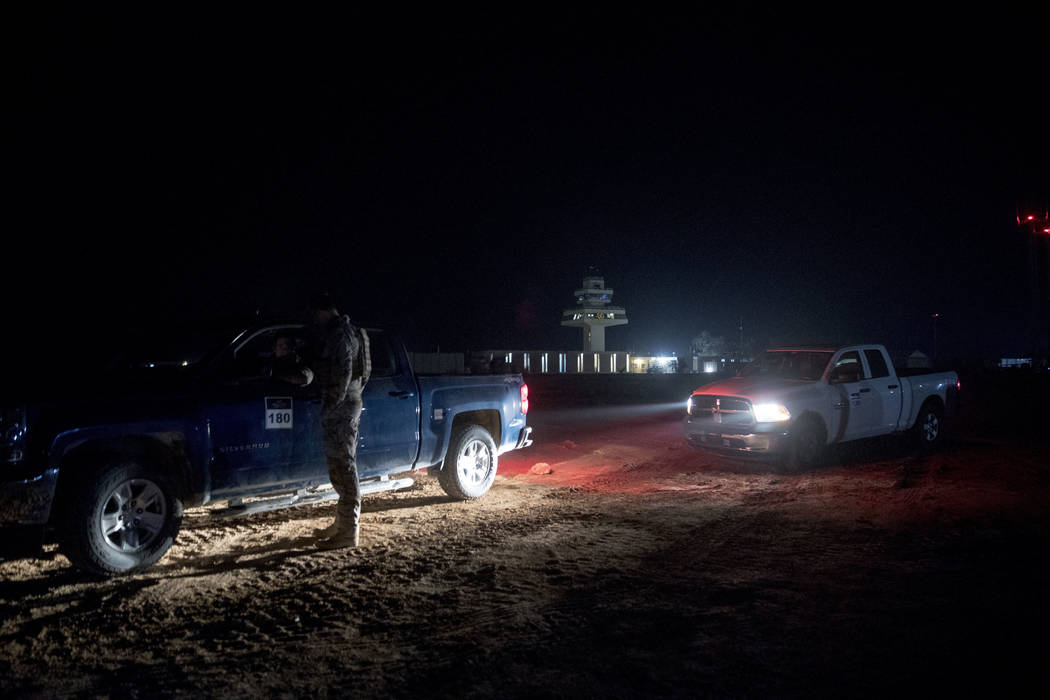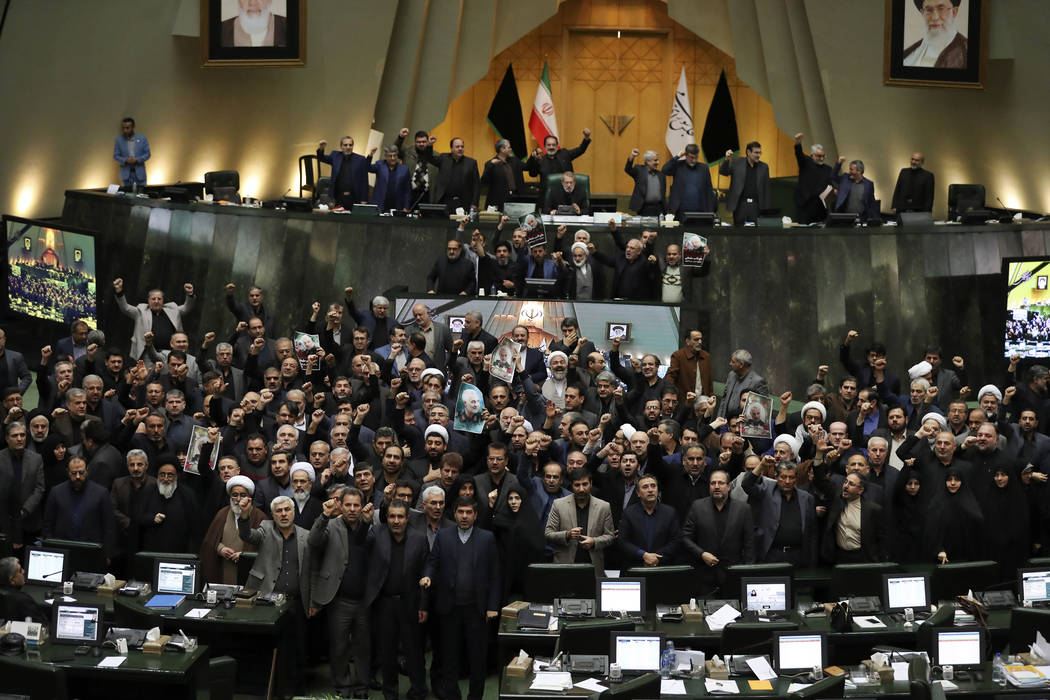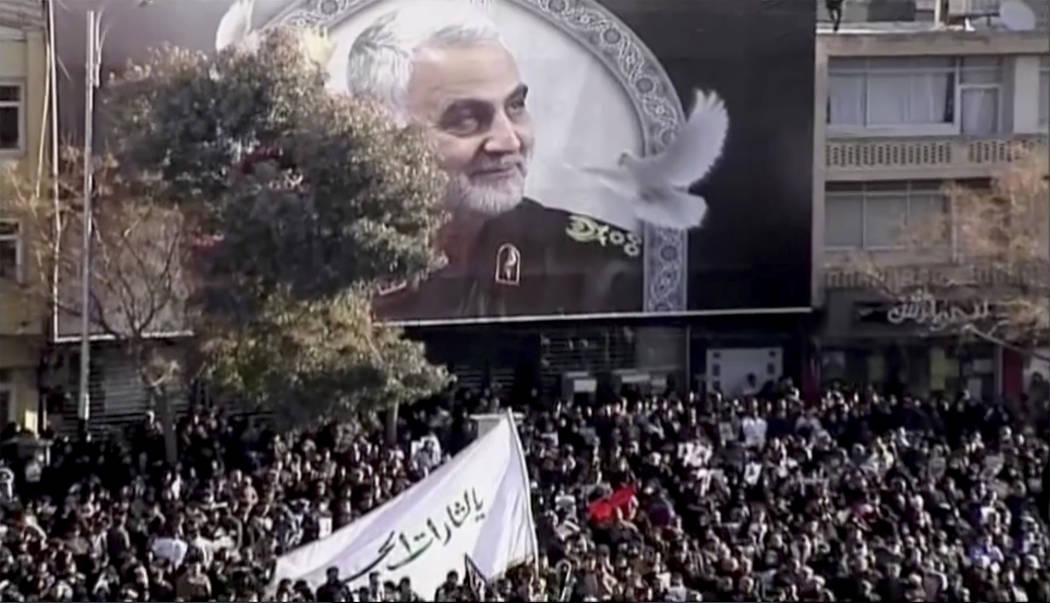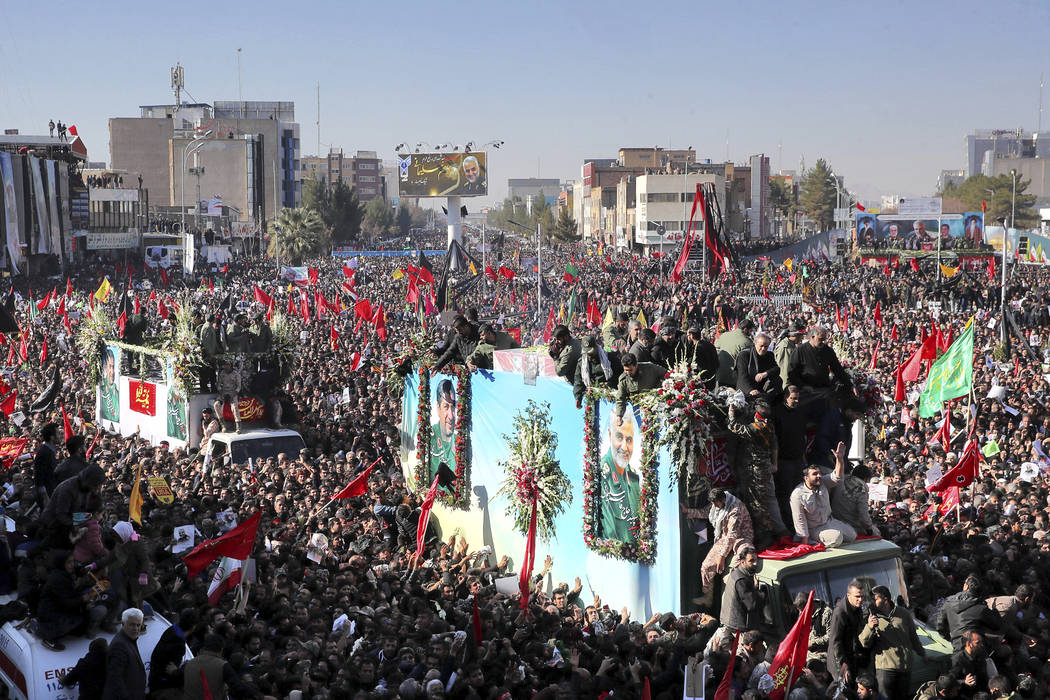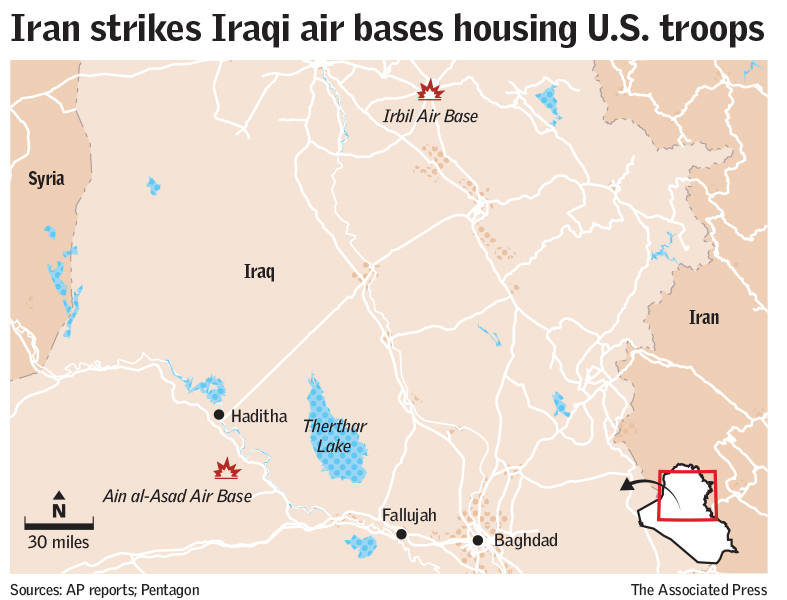Iran fires 15 missiles at U.S. forces at Iraqi air bases
TEHRAN, Iran — Iran struck back at the United States for the killing of Iranian Maj. Gen. Qassem Soleimani early Wednesday, firing a series of surface-to-surface missiles at an Iraqi air base housing U.S. troops and warning the United States and its allies in the region not to retaliate.
U.S. officials confirmed airstrikes at the air base. There was no immediate word on injuries.
It was Iran’s most direct assault on America since the 1979 seizing of the U.S. Embassy in Tehran, and Iranian state TV said it was in revenge for the U.S. killing of Revolutionary Guard Gen. Qassem Soleimani, whose death last week in an American drone strike near Baghdad prompted angry calls to avenge his slaying. A U.S. and Iraqi officials said there were no immediate reports of casualties, though buildings were still being searched. The Iraqi government later confirmed there were no casualties among Iraqi forces.
A presenter on Iranian state television later claimed, without offering evidence, that the strikes killed “at least 80 terrorist U.S soldiers” and also damaged helicopters, drones and other equipment at the Ain al-Asad air base.
The killing of Soleimani on Friday was a U.S. response to a December attack on the U.S. Embassy in Iraq and was based on intelligence that Soleimani was planning further attacks on U.S. diplomats and service members.
Iran’s Revolutionary Guard warned the U.S. and its regional allies against retaliating over the missile attack against the Ain Assad air base in Iraq’s western Anbar province. The Guard issued the warning via a statement carried by Iran’s state-run IRNA news agency.
“We are warning all American allies, who gave their bases to its terrorist army, that any territory that is the starting point of aggressive acts against Iran will be targeted,” The Guard said. It also threatened Israel.
Iran has long vowed to destroy Israel.
Ain al-Asad air base was first used by American forces after the 2003 U.S.-led invasion that toppled dictator Saddam Hussein, and later saw American troops stationed there amid the fight against the Islamic State group in Iraq and Syria. It houses about 1,500 U.S. and coalition forces. The U.S. also acknowledged another missile attack targeting a base in Irbil in Iraq’s semi-autonomous Kurdish region.
The Iranians fired a total of 15 missiles, two U.S. officials said. Ten hit Ain al-Asad and one the base in Irbil. Four failed, said the officials, who were not authorized to speak publicly about a military operation.
Two Iraqi security officials said at least one of the missiles appeared to have struck a plane at the Ain al-Asad base, igniting a fire. There were no immediate reports of casualties from the attacks, according to the officials, who spoke on condition of anonymity as they had no permission to talk to journalists.
State TV said the operation’s name was “Martyr Soleimani.” It said the Guard’s aerospace division that controls Iran’s missile program launched the attack. Iran said it would release more information later.
Wednesday’s revenge attack came a few hours after crowds in Iran mourned Soleimani and as the U.S. continued to reinforce its own positions in the region and warned of an unspecified threat to shipping from Iran in the region’s waterways, crucial routes for global energy supplies.
U.S. embassies and consulates from Asia to Africa and Europe issued security alerts for Americans. The U.S. Air Force launched a drill with 52 fighter jets in Utah, just days after President Donald Trump threatened to hit 52 sites in Iran.
A stampede broke out Tuesday at Soleimani’s funeral for a top Iranian general slain in a U.S. airstrike, and at least 56 people were killed and more than 200 were injured as thousands thronged the procession, Iranian news reports said.
Tuesday’s deadly stampede took place in Soleimani’s hometown of Kerman as his coffin was being borne through the city in southeastern Iran, said Pirhossein Koulivand, head of Iran’s emergency medical services.
There was no information about what set off the crush in the packed streets, and online videos showed only its aftermath: people lying apparently lifeless, their faces covered by clothing, emergency crews performing CPR on the fallen, and onlookers wailing and crying out to God.
“Unfortunately as a result of the stampede, some of our compatriots have been injured and some have been killed during the funeral processions,” Koulivand said, and state TV quoted him as saying that 56 had died and 213 had been injured.
Soleimani’s burial was delayed, with no new time given, because of concerns about the huge crowd at the cemetery, the semi-official ISNA news agency said.
A procession in Tehran on Monday drew over 1 million people in the Iranian capital, crowding both main avenues and side streets in Tehran.
Such mass crowds can prove dangerous. A smaller stampede at the 1989 funeral for Ayatollah Ruhollah Khomeini killed at least eight people and injured hundreds.
Hossein Salami, Soleimani’s successor as leader of the Revolutionary Guard, addressed a crowd of supporters gathered at the coffin in a central square in Kernan. He vowed to avenge Soleimani, who was killed in a U.S. drone strike Friday near Baghdad’s airport.
“We tell our enemies that we will retaliate but if they take another action we will set ablaze the places that they like and are passionate about,” Salami said.
“Death to Israel!” the crowd shouted in response, referring to one of Iran’s longtime regional foes.
Salami praised Soleimani’s work, describing him as essential to backing Palestinian groups, Yemen’s Houthi rebels and Shiite militias in Iraq and Syria. As a martyr, Soleimani represented an even greater threat to Iran’s enemies, Salami said.
Soleimani was the head of Iran’s terrorist Quds Force and the architect of the country’s terrorist proxies from Afghanistan to Yemen, including Hezbollah and Hamas.
Soleimani will ultimately be laid to rest between the graves of Enayatollah Talebizadeh and Mohammad Hossein Yousef Elahi, two former Guard comrades killed in Iran’s 1980s war with Iraq.
They died in Operation Dawn 8, in which Soleimani also took part. It was a 1986 amphibious assault that cut Iraq off from the Persian Gulf and led to the end of the war that killed 1 million.
The U.S. blames Soleimani for killing U.S. troops in Iraq and accused him of plotting new attacks just before he was killed. Soleimani also led forces supporting Syrian President Bashar Assad in that country’s civil war, and he also served as the point man for Iranian proxies in countries like Iraq, Lebanon and Yemen.
Russian President Vladimir Putin met with Assad in Syria on Tuesday amid the tensions between Washington and Tehran.
In Iraq, pro-Iranian factions in parliament have pushed to oust American troops from Iraqi soil following Soleimani’s killing. Germany and Canada announced plans to move some of their soldiers in Iraq to neighboring countries.
According to a report on Tuesday by the semi-official Tasnim news agency, Iran has worked up 13 sets of plans to avenge Soleimani’s death. The report quoted Ali Shamkhani, the secretary of Iran’s Supreme National Security Council, as saying that even the weakest among them would be a “historic nightmare” for the U.S. He declined to elaborate,
“If the U.S. troops do not leave our region voluntarily and upright, we will do something to carry their bodies horizontally out,” Shamkhani said.
The state-run IRNA news agency later published a statement from the Supreme National Security Council denying Shamkhani made the comment.
The U.S. Maritime Administration warned ships across the Mideast, citing the rising threats. “The Iranian response to this action, if any, is unknown, but there remains the possibility of Iranian action against U.S. maritime interests in the region,” it said.
Oil tankers were targeted in mine attacks last year that the U.S. blamed on Iran. Tehran denied responsibility, although it did seize oil tankers around the crucial Strait of Hormuz, the narrow mouth of the Persian Gulf through which 20 percent of the world’s crude oil travels.
The U.S. Navy’s Bahrain-based 5th Fleet said it would work with shippers in the region to minimize any possible threat.
The 5th Fleet “has and will continue to provide advice to merchant shipping as appropriate regarding recommended security precautions in light of the heightened tensions and threats in the region,” 5th Fleet spokesman Cmdr. Joshua Frey told The Associated Press.
Meanwhile, Iranian Gen. Alireza Tabgsiri, the chief of the Guard’s navy, issued his own warning.
“Our message to the enemies is to leave the region,” Tabgsiri said, according to ISNA. The Guard routinely has tense encounters with the U.S. Navy in the Persian Gulf.
Separately, Iran summoned the British ambassador over comments by Prime Minister Boris Johnson and the British defense minister about Soleimani’s killing, the semi-official Mehr news agency reported.
Iran’s parliament, meanwhile, has passed an urgent bill declaring the U.S. military’s command at the Pentagon and those acting on its behalf in Soleimani’s killing as “terrorists,” subject to Iranian sanctions. The measure appears to be in response to a decision by Trump in April to declare the Revolutionary Guard a “terrorist organization.”
The U.S. Defense Department used that terror designation to support the strike that killed Soleimani. The action by Iran’s parliament was done by a special procedure to speed it into law and also saw the lawmakers approve funding for the Quds Force with an additional 200 million euros, or about $224 million.
Also Tuesday, Iranian Foreign Minister Mohammad Javad Zarif said the U.S. had declined to issue him a visa to travel to New York for meetings at the United Nations. As the host of the U.N. headquarters, the U.S. is supposed to allow foreign officials to attend such meetings.
“This is because they fear someone will go there and tell the truth to the American people,” Zarif said. “But they are mistaken. The world is not limited to New York. You can speak with American people from Tehran too and we will do that.”
Asked about Zarif, U.S. Secretary of State Mike Pompeo told journalists America would comply with its obligations under U.N. rules to grant visas. He then referred to the Iranian diplomat as “a propagandist of the first order.”
A U.S. official who wasn’t authorized to speak on the record said the application couldn’t be processed in time for Zarif’s travel although it wasn’t clear if his request had been formally denied. A formal rejection would trigger legal technicalities that could affect future visa applications and could violate the host country agreement the U.S. has with the U.N.




